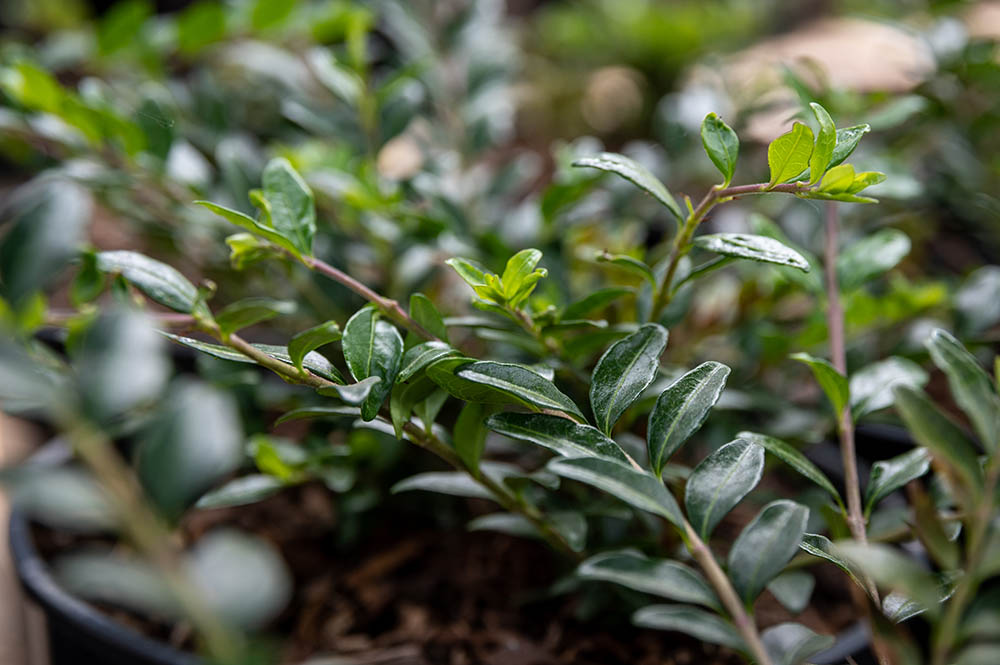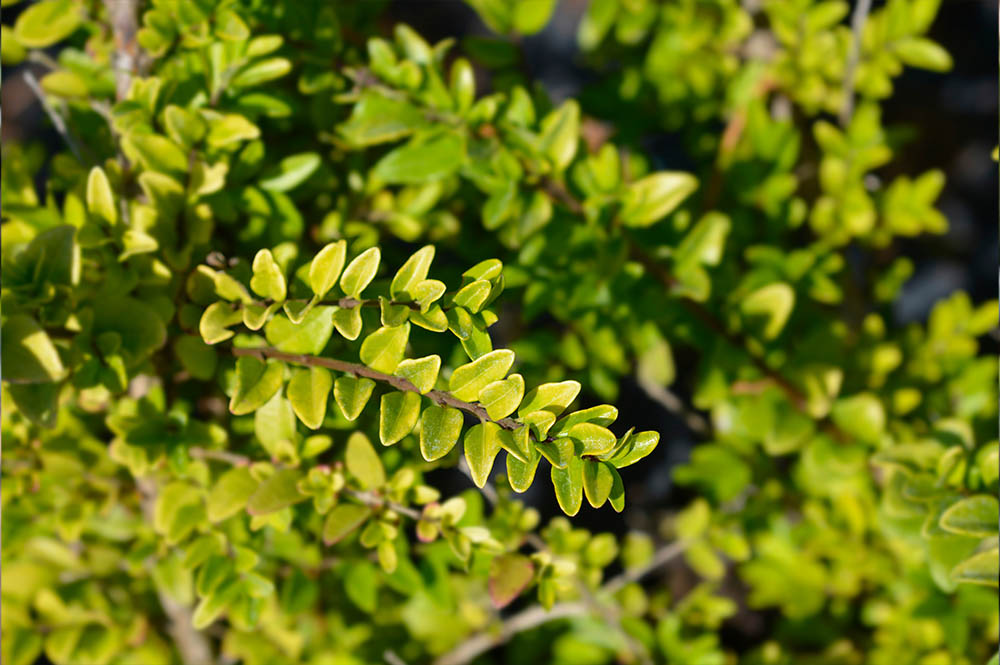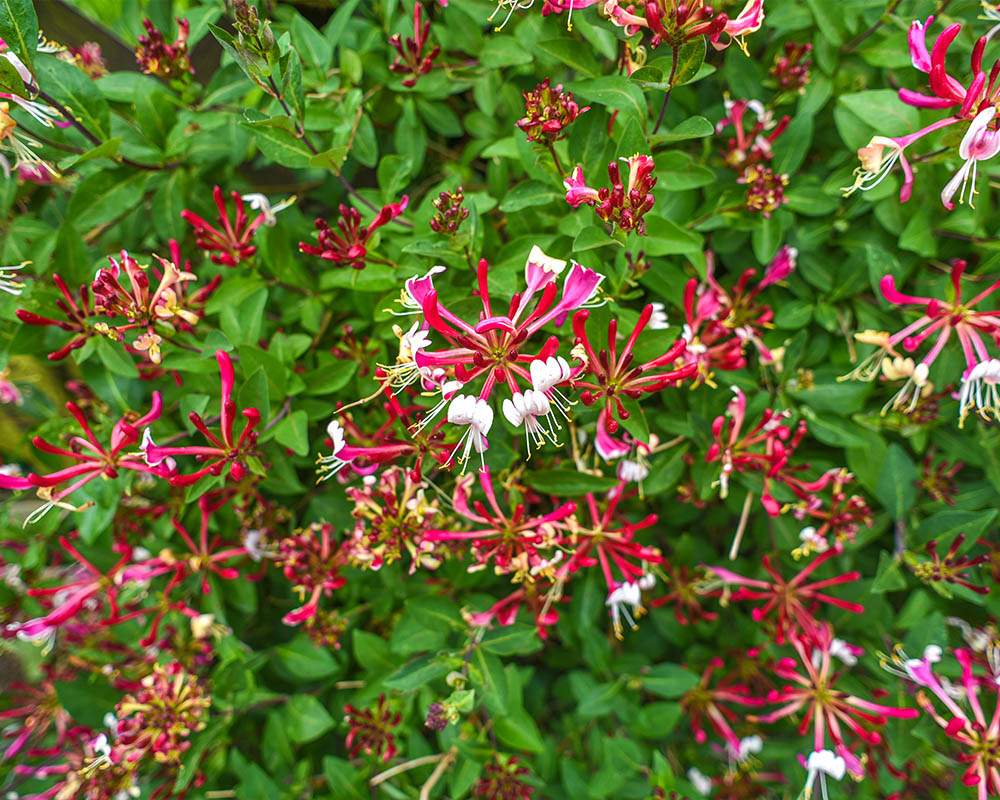Plant Focus: Lonicera (Honeysuckle)
Hardy, spring-flowering climbers and shrubs to provide colourful interest to your landscapes.
Lonicera, most commonly known as Honeysuckle, is a genus of plant that can contain species of arching shrubs, and twining vines. It’s part of the Caprifoliaceae clade of plants, along with other genera such as Symphoricarpos (snowberry) and Weigela. The name Lonicera is derived from the renaissance naturalist and physician Adam Lonitzer, who wrote several influential works on plants and herbs. It’s an incredibly eclectic, widespread genus, covering most of the Northern Hemisphere natively, containing over 180 different species within the genus. Whilst most commonly known as a climbing plant, there are many species of Lonicera which have a dense, shrubby growth habit, and species such as Lonicera nitida are commonly grown as hedges.
Key Characteristics:
✓ Evergreen or Deciduous
✓ Both climbing and shrub varieties
✓ Leaves 1-10cm in length depending on species
✓ Prefers sun or partial shade
✓ Grows best in moist but well-drained soil
✓ Produces large flowers in spring
✓ Berries grow in autumn in certain varieties.
✓ Shrubs work well as a Buxus
The characteristics of Lonicera vary between each species. Many are evergreen, including Lonicera nitida and Lonicera japonica, yet equally there are also many deciduous species, such as Lonicera caprifolium and Lonicera periclumenum. Most species, particularly the deciduous varieties of Lonicera produce incredible colourful, fragrant flowers in springtime, which provide visual interest and nutrition to wildlife early in the seasonal cycle. With climbing Lonicera, its foliage is glossy and ovate in shape, and grows up to 10cm in length, depending on the species. The evergreen shrub varieties have much smaller, dense foliage, similar to evergreen shrubs such as Buxus. With the prevalence of Box blight affecting the health of Buxus species across the country, shrubby evergreen Lonicera plants make for a suitable alternative. Both climbers and shrub varieties of Lonicera have a maximum height of around 5m, depending on the species, with some species having a maximum growth of just one metre.

Climbing Lonicera tends to prefer moist but well-drained soil, with partial sunlight. They grow best with shaded roots, but with their stems in regular sunlight. To get the best growth, make sure to provide a sturdy structure on which they can climb, such as a fence or a trellis. When it comes to Lonicera shrubs, moist to well drained soils are best suited, but can grow in either full sun or partial shade. Both types of Lonicera will grow well in most soils, but for best results, a hummus rich soil is advised.
Fun Fact
Despite being prized for their magnificent flowers in Spring, certain species of Lonicera, including Lonicera japonica, are actually considered pests in New Zealand and parts of North America, even being banned in several US states. This is due to their aggressive, spreading growth habit, being able to outcompete other plants for sunlight and soil nutrients.
Our favourite Lonicera species:
Lonicera nitida
A dense, bushy, evergreen shrub with small, dark green leaves. When planted in areas of good sunlight, it produces small, cream flowers in spring, followed by blue-purple berries in autumn. Fast growing and is an ideal choice for formal hedging.
Lonicera nitida ‘Maigrün’
A dense, vigorous, evergreen shrub with tiny, mid-green leaves. New growth provides a lovely contrast as these leaves are pale green in colour. In spring, it blooms lightly scented, creamy-white flowers which are followed by dark purple berries in late summer. Lonicera nitida ‘Maigrün’ is lovely for low hedging and can cope with coastal locations.

Lonicera nitida

Lonicera nitida ‘Maigrün’
Lonicera nitida ‘Baggesen’s Gold’
A dense, evergreen shrub with golden-yellow summer foliage which turns bronze from autumn to winter. Blooms small, cream flowers in spring. Perfect for providing some unique colour to a planting scheme or hedgerow.
Lonicera pileata
A fast-growing, spreading shrub with glossy, dark green leaves, small, cream flowers in spring and purple ornamental berries in autumn. Lovely for growing as a compact hedge. Prefers well-drained soils, and is flexible due to its ability to thrive in both full sun and part shade.
Lonicera pileata ‘Loughgall evergreen’
A mound-forming, low-growing shrub with glossy, oval-shaped, dark green foliage. Blooms funnel-shaped, creamy-white flowers in spring, followed by purple fruit. Ideal for groundcover due to its spreading growth habit, but can be formed into a compact hedge.

Lonicera pileata ‘loughgall evergreen’

Lonicera periclymenum
Lonicera pileata ‘Moss green’
A compact, groundcover shrub it has dark green, glossy, lance-shaped foliage and white, spring flowers, followed by violet fruits. A great foil for brightly coloured, flowering plants. Grows naturally on slopes and open forests in central to southeastern China.
Lonicera periclymenum
A vigorous, shrubby climber with oval-shaped, green foliage and highly-scented, tubular, white, purple-flushed flowers in summer. Glossy, red berries follow in autumn. Lonicera periclymenum can grow up to 8m in length when supported.
Lonicera japonica ‘Halliana’
A vigorous Evergreen climbing plant that bears yellow and white flowers in summer, despite being considered a pest in some regions, its flowers are well regarded in others, having once been awarded the prestigious RHS ‘Award of Garden Merit’.
How to grow and care for Lonicera
Deciduous varieties should be planted in late winter, whilst the roots are at their hardiest, ensuring minimal shock to the plant, whereas evergreen Lonicera can be planted in either spring or autumn. To prepare the soil, ensure to mix some peat-free compost into the soil, then dig a hole the same size as the rootball or container. Ensure the plant is at the same depth it was originally in the pot, and continue to mulch in organic matter to help with water retention. Backfill with soil, and be sure to water well after planting. To aid the growth of climbers, ensure to add some guides in the form of wires or bamboo, and ensure the plant is able to cling to the support.
Lonicera will struggle in dry summers, so ensure to water regularly to ensure the soil is consistently moist. In winter, make sure to avoid rain shadows at the base of walls, that receive little to no rainfall.
When pruning climbers, make sure to cut back in summer after the plant has flowered. Ensure to cut back a maximum of one third of the plant, and avoid removing dying flowers, as these will turn to berries. With deciduous shrubs, they can be pruned in spring once they have flowered, whereas evergreen shrubs can be pruned in summer.
Pests & Diseases
One of the major issues that affect Lonicera, particularly climbers, are ‘Honeysuckle aphids’. The leaves will become warped and will begin to curl as the insects feed on the foliage. The aphids also will leave behind honeydew, which encourage mould growth. This affects plants in poorer health, so ensure to remove any shoots that are looking unhealthy. Planting climbing Lonicera varieties in partial shade will help to mitigate this issue. Powdery mildew can also be an issue for most varieties, so ensure to mulch around the base in spring to avoid this.
To learn more about the Lonicera species that we grow and sell, speak to the G team today

